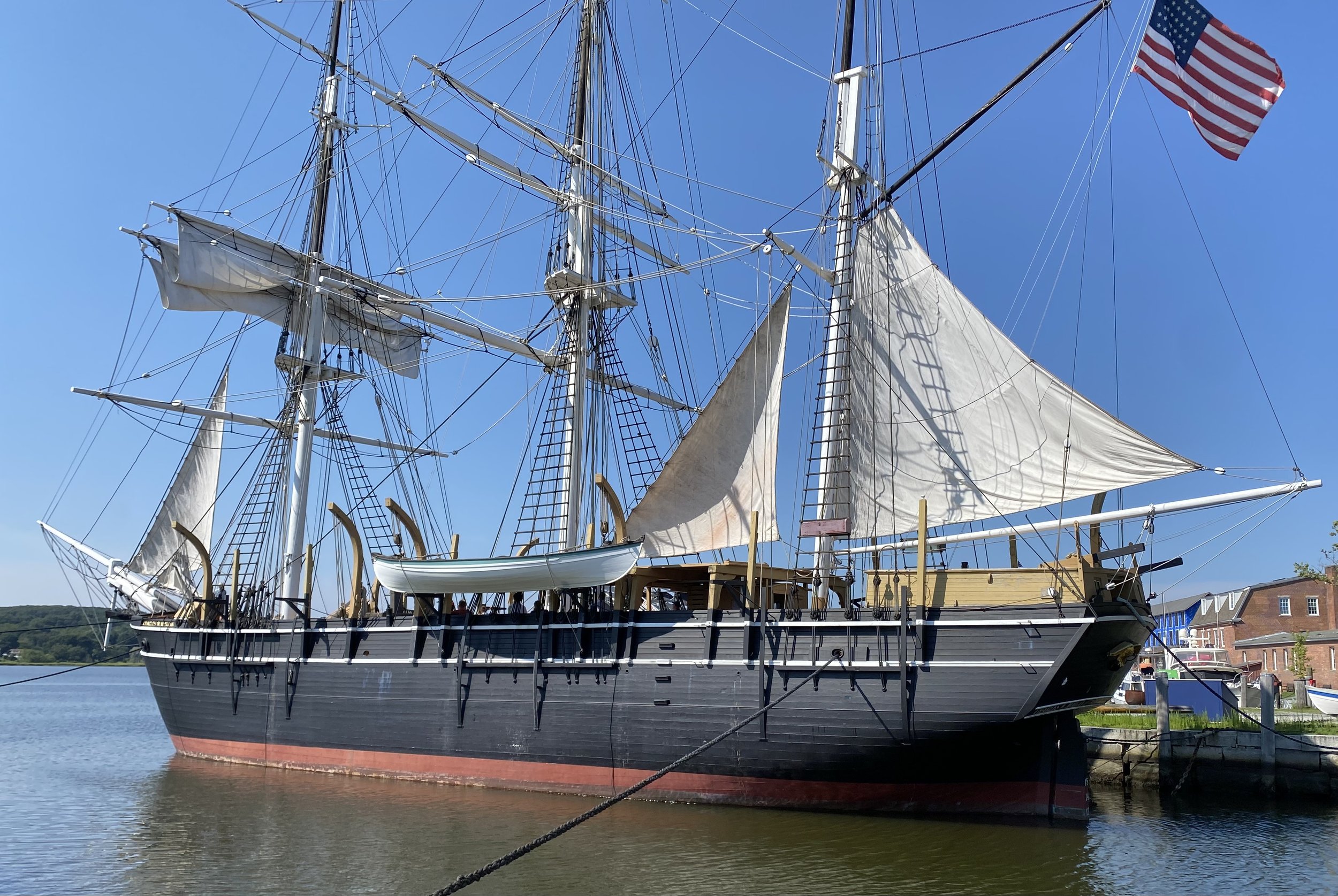Dive into Mariner Marvels at Mystic, Connecticut's Seaport Museum
Published August 25th, 2024
Photography by Maureen Littlejohn
Mystic, Conneticut, is not a village filled with mystics. But it is filled with mariner magic I learned on a recent visit. Located on the Mystic River, near where it drains into Long Island Sound, it’s a charming berg filled with ice cream parlors, funky boutiques, and delicious seafood restaurants.
First settled in 1784, Mystic was originally known as a seaport and ship-building hub. More than 600 vessels were built here, in the age the sail.
These days, one of its main attractions is the Mystic Seaport Museum.
I had no idea what to expect when a friend suggested we visit the museum as part of our village explorations. I thought it might be a musty place with glass cases full of old sailors’ paraphernalia.
Tread the Decks of Ancient Ships
Even though it was founded in 1929, musty and tired it was not. Upon entry, I received a map and guide of the 19-acre property. It outlined a recreated New England coastal village complete with a working shipyard, blacksmith’s shop, grocery store, school house, lobster shack, oyster shack, bank, cooperage, print shop, and a tavern.
Reading the guide, I learned the museum was home to 500 historic watercraft, four National Historic Landmark vessels, exhibit halls (figureheads, art, glass, and more), a planetarium, and a children’s museum.
Following the map, I made a beeline to North America’s last remaining wooden whaling ship, the Charles W. Morgan. Built in 1841, she was a three masted beauty and America’s oldest commercial ship still afloat. Climbing on board, I was directed by a docent to see the captain’s quarters, as well as the cramped crew bunks below deck. This 106-foot ship would go around the world for three years at a time to hunt the giants of the sea. Coal-fired try-pots on deck would be fired up night and day to render the whale blubber. I can’t imagine how it must have smelled.
On an exhibit plaque, I read about five captains of the ship who went to sea with their wives. Strong women. Don’t know if I could have done it.
See how Boats are Built
I was intrigued by the working shipyard, where the hulls of the L.A. Dunton (1921) and the Mayflower II (1957), were undergoing overhauls. The Dunton was stripped right down and her rotten timbers were being replaced. The Mayflower was having her seams re-caulked and other repairs done.
The shipyard offered a bird's eye view of smaller boats being worked on in the main shop and there was an exhibit gallery that explained why different wood was used for other parts of the ship. Live oak, I learned, was very heavy and a favorite for the interior hulls of warships.
Where Kids Can Learn
Docked in another part of the Seaport Museum was the Joseph Conrad. Built in 1882 in Copenhagen, the 111-foot full-rigged ship was used to train young Danish sailors in the Baltic and North Seas. A freighter ran her down and she sank in 1905, taking 22 men with her. Raised and repaired, she continued as a training ship. In 1934 she was bought by a British captain who sailed her around the world for two years. Later she was converted into a private yacht and then spent another few years as an American training ship before coming to the Mystic Seaport Museum in the late 1940s.
Now she’s a hub for children’s programs including summer camp.
See the Original Rope-a-Dope
Located by the Joseph Conrad was a building I found fascinating. The Ropewalk was a 250-foot segment of the Plymouth Cordage Company’s ropewalk.
What the heck is a ropewalk? It had nothing to do with tightropes. The original 1824 building came from Plymouth, Mass. It was more than 1,000 feet long and it’s where rope was made. I had no idea that when the strands of natural fibers such as hemp or abaca were twisted together the whole procedure had to be one in a straight line. Strands were twisted together in opposite directions at each step and the tension was what held the rope tight.
Check out how James Cameron got to the Bottom of the Sea
Everything at the Mystic Seaport Museum is not ancient. But it is historic.
Wandering into the village green, I spied a tent and peeked underneath. James Cameron’s Deep Sea Challenger sat there in all its lime-green glory. In 2012 he climbed into the submarine’s small pilot’s bubble and made a record-breaking solo dive 11 kilometres to the Mariana Trench, the Earth’s deepest point.
Take a River Trip
The museum also offered visitors a chance to get out onto the water. Steamboat Sabino, for an extra fee, took passengers out for a leisurely cruise on the Mystic River. A coal-fired wooden steamboat, Sabino was built in 1908 and is one of two surviving members of the American mosquito fleet.
Rowboats, sailboats, and pedal boats were also available for an hour and the cost was included with admission.
Mystic Munches
S&P Seafood: Great river views and outdoor terrace. Nice for lunch.
Shipwrights Daughter: James Beard award-winning chef. Breakfast or dinner.
The Oyster Club: Good for dinner and the Treehouse deck is also open for lunch.
Mystic Pizza: A slice of heaven and a fave for fans of the 1988 Julia Roberts movie.
Drawbridge Ice Cream: This location has been making creamy concoctions since the 1800s.
Other Things to Do
Art galleries, aquarium, shopping, paddling, hiking, and more. Check out Think Mystic.








